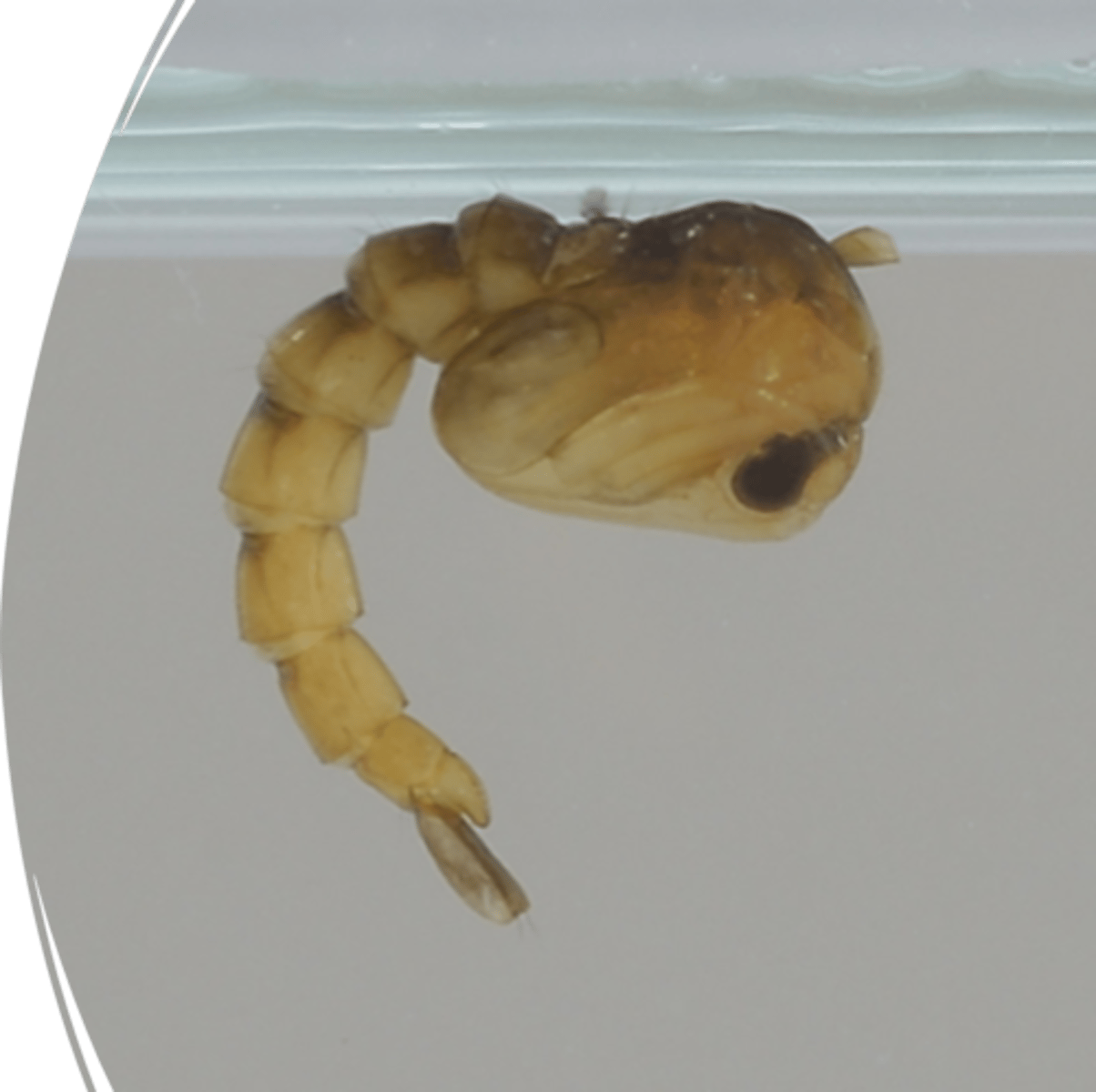Medicinal Entomology Midterm
1/255
There's no tags or description
Looks like no tags are added yet.
Name | Mastery | Learn | Test | Matching | Spaced |
|---|
No study sessions yet.
256 Terms
entomology
from the Greek "entomon" meaning "cut up or divided into segments"
3 basic characteristics of arthropods
jointed appendages, segmented body, external skeleton
Types of problems caused by arthropods
• Annoyance/nuisance
• Toxins and Venoms
Diseases caused by arthropods
• Disease: Destruction of host tissues
• Called "myiasis" when done by fly larvae
• Disease = vector-borne diseases
• Disease = Food contamination
• Disease = Allergic reactions
• Disease = Psychological stress
• Fear
• Delusional disorders (eg. Morgellons disease)
Mosquito
The most dangerous animal. Kills 725,000 people a year
Malaria
Vector borne disease from mosquitos. Kills 600,000 a year
Koch's postulates (1884)
Germ theory of disease versus Miasma theory
Patrick Manson
Founder of the tropical medicine field
Role of mosquitoes inhuman elephantiasis (1877)
Theobald Smith
Discovered the causative agent of Texas cattle fever was vectored by the cattle tick.(1893)
Ronald Ross
Described the life-cycle of the parasites of malaria (1897)
Walter Reed
Demonstrated the role of Aedes mosquitoes in the transmission of yellow fever. (1900)
William Burgdorfer, Alan Barbour, Jorge L. Benach
Discovery of the agent of Lyme Disease (1982)
Koch's Postulates
a sequence of experimental steps for directly relating a specific microbe to a specific disease
Vector-borne diseases
Diseases transmitted by vectors like mosquitoes.
Vector
an organism, typically a biting insect or tick, that transmits a disease or parasite from one animal or plant to another.
mechanical vector transmission
picks up an infectious agent on the outside of its body and transmits it in a passive manner
biological vector transmission
pathogens are within the vector and transmission to the host is through a bite (ex. plague)
Propagative transmission
parasite multiplies within the vector without any cyclical changes (parasite increases in number within the vector but does not undergo any developmental changes)
Cyclodevelopmental transmission
The parasite undergoes cyclical changes within the vector but does not multiply, i.e., there is only developmental changes of the parasite without multiplication.
Cyclopropagative transmission
The parasite undergoes cyclical changes and multiplies within the vector, i.e., there are both developmental changes and multiplication of the parasite
Four criteria used to identify primary vectors
1. associate and feed on the reservoir and its seasonality should coincide with the incidence of vertebrate infection
2. be commonly found infected with the disease agent
3. be shown to become infected experimentally
4. be shown to be capable of transmitting the disease to an uninfected host
vectorial capacity
equation that accounts for the major factors of pathogen transmission by mosquitoes and is defined as the average number of new vertebrate infections per day resulting from an initial index case
V=ma^2 p^n / - ln (p)
The ratio of mosquitoes to humans ( m ); human biting rates ( a ); mosquito survival through one day ( p ); pathogen latent period (n days)
4 components vectorial capacity depends on
1. number of mosquitos
2. feeding frequency and type
3. survivorship
4. vector competence
bridge vector
organism that transmits a pathogen from one animal host to a human
Enzootic vector
organism, typically a biting arthropod, that transmits a pathogen from one animal host to another
Risk (probablity) of human infection
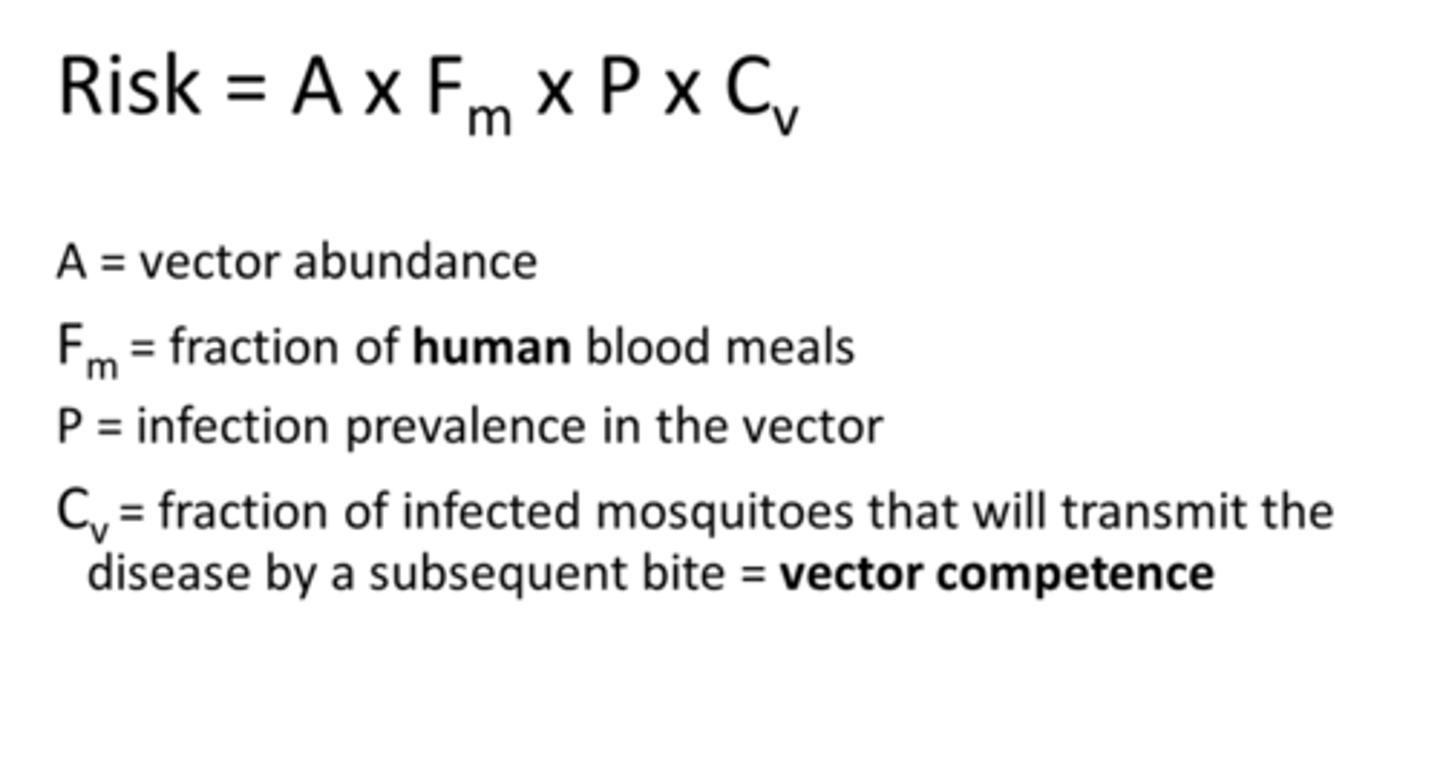
endemic disease
disease constantly present in a population
epidemic disease
is the rapid spread of disease to a large number of patients among a given population within an area in a short time.
pandemic disease
an epidemic disease that occurs worldwide
Enzootic
an endemic disease present in an animal population, no humans
epizootic
is the rapid spread of disease to a large number of patients among a given population within an area in a short time.
Invasive mosquitos
Are the drivers of most recent epidemics of mosquito-borne diseases (Culex, Aedes)
Mosquito-borne diseases
òYellow fever
òDengue (DHF)
òWest Nile encephalitis
òRift Valley fever
òChikungunya
òZika fever
òUrban malaria
parts of the mosquito
head, thorax, abdomen
Mosquito Taxonomy
Kingdom: Animalia
Phylum: Arthropoda
Class: Insecta
Order: Diptera
Family: Culicidae
Subfamily: Anophelinae or Culicinae
mosquitos
38 genera organized in 11 tribes, 3500 species
Morphological differences between Anophelinae and Culicinae in relation to the stages.

Anopheles gambiae
malaria and human filariasis
Culex pipiens
West Nile, bird malaria, St. Louis encephalitis
Aedes spp.
denge, yellow fever, Zika, chikungunya
Aedes aegypti
yellow fever mosquito
Aedes albopictus
Asian tiger mosquito
Anthropophilic
Preferring or seeking a human host over another animal. Supplement. The term anthropophilic is used to describe parasites that prefer or seek human as host rather than other animals.
Endophilic
having an attraction to or preference for indoor environments
endophagic
feeds indoors
Mosquito eggs
Culex: no floats (laid in rafts on water)
Aedes: no floats (laid beside water)
Anopheles: Lateral floats (laid on water)
Anopheles morphology
Rest parallel to water surface (no siphon)
Aedes & Culex morphology
Rest at angle to water surface (siphon)
mosquito life cycle
egg, larva, pupa, adult
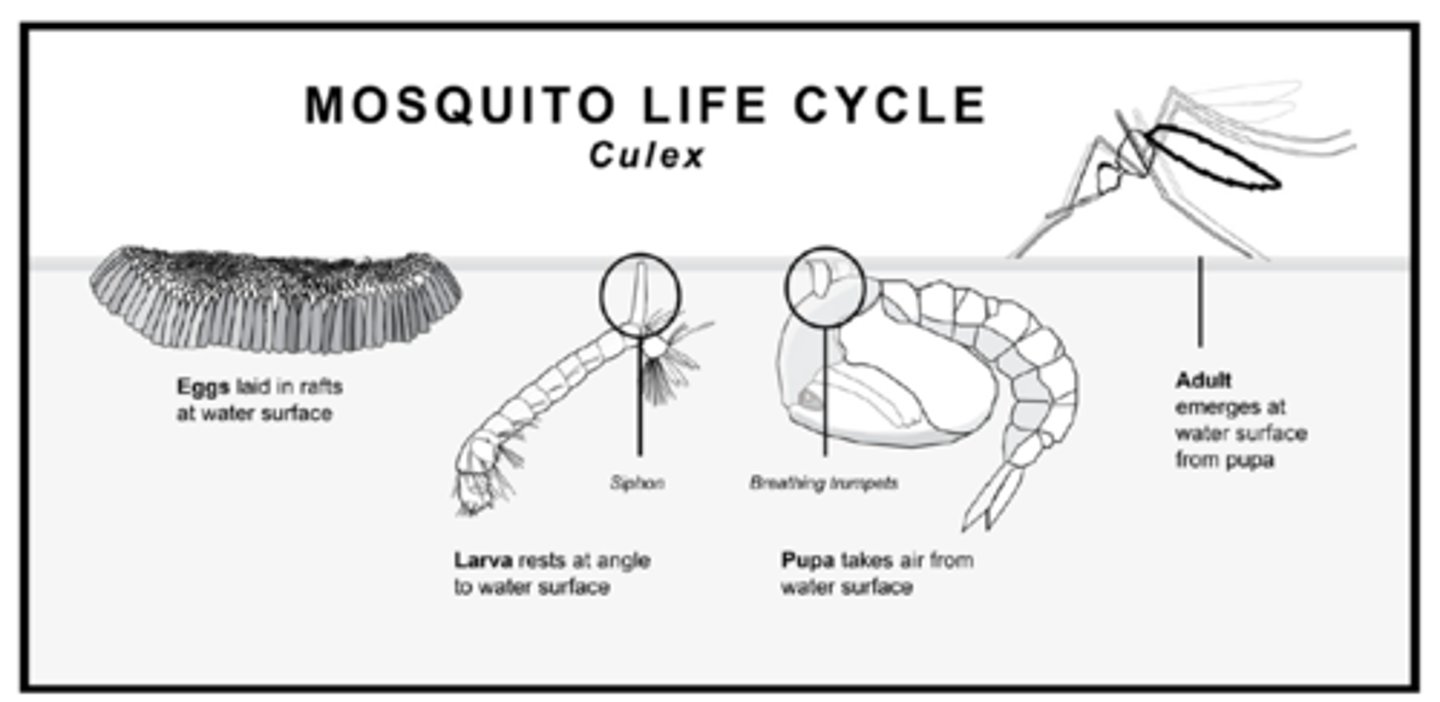
Aedes aegypti
tropical invasive mosquito (expanded worldwide after 1500s)
Aedes albopictus
Expanded worldwide after 1960s, tropical and temperate invasive mosquito
Aedes japonicus japonicus
(expanded worldwide after 1990s) temperate invasive mosquito
Phylum Arthropoda
largest phylum in the animal kingdom
Arthropod characteristics
•Exoskeleton (hardened plates with flexible joints) made predominantly of chitin (a nitrogenous polysaccharide = polymer of n-acetyl-glucosamine)
•Articulated appendages
•Segmentation
•Open circulatory system
•Hemolymph
•Specialized excretory structures, Malpighian tubules.
Exoskeleton
an external skeleton that supports and protects an animal's body.
1. Protection against predator
2. Support: it provides an attachment framework for muscles.
3. Protects against desiccation.
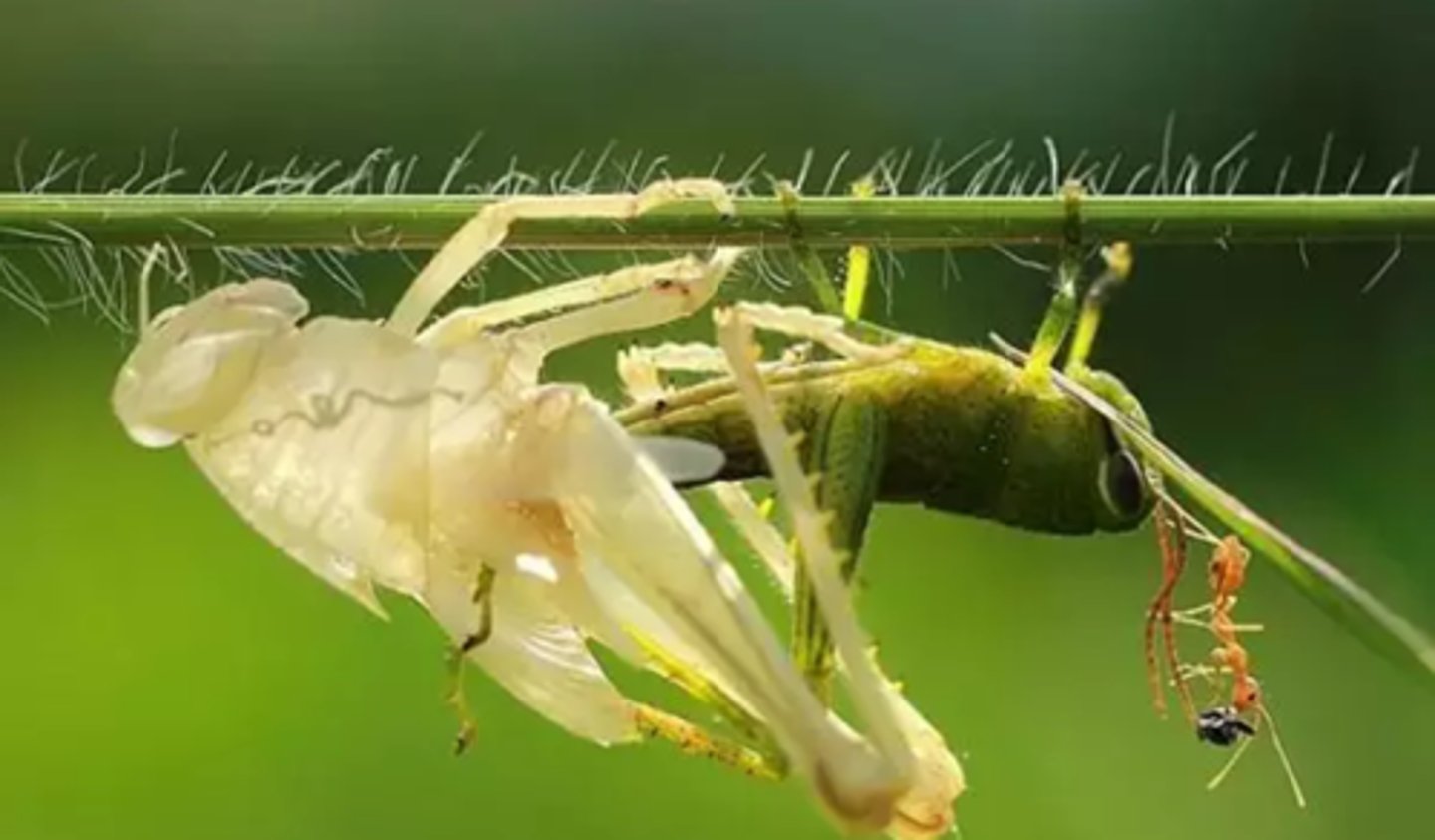
Ecdysis
periodic shedding of the cuticle in arthropods
cuticle of arthropods
Outermost portion of the animal (exoskeleton) made of proteins and calcium; secreted by underlying cells and periodically molted during growth.
exuviae
shed exoskeleton
Epicuticle
The outermost layer of the insect cuticle designed to prevent water loss.
Procuticle
inner thick layer of an arthropod shell that consists primarily of layers of protein and chitin
diatomaceous earth
fossilized remains of diatoms, a type of hard-shelled microalgae
hemolymph
has the same functions of the vertebrate blood and lymph combined (except that oxygen reaches cells through the tracheal system - CO2 dissolves and is excreted by the Malpighian tubes). Also acts as a physical force (hydraulic) to extend proboscis, reproductive organs, molt.
hemocytes
wound repair, detoxification, immunity
Ametabolous
undergoing slight or no metamorphosis
Hemimetabolous
Incomplete metamorphosis where the immature resemble the adults but some features are missing or different (wings, reproductive organs, color, shape, etc.). no pupal stage.
Holometabolous
Complete metamorphosis; egg, larva, pupa, adult
telmophagous
pool feeders
solenophages
Penetrate capillaries & feed directly
Myiasis
infestation by larvae of flies usually through a wound or ulcer
two main fly families that cause myiasis
Calliphoridae (blow flies) and Muscidae (House flies, Stable flies)
Pseudomyiasis
- Accidental myiasis.
- Dipterous larvae found in the GI of man or animals which have been accidentally ingested with food or water.
- Normally no pathological manifestaions.
Sacrophagidae
flesh flies
Facultative myiasis
can eat either dead or living flesh; opportunistic
primary myiasis
species that can initiate myiasis
secondary myiasis
species that invade already compromised tissues
tertiary myiasis
species that join primary and secondary species just prior to host death
Obligatory myiasis
completely parasitic dipteran fly larvae; require a living host; always parasitic
Temporary myiasis
intermittent contact between a fly larva and host
Incidental Myiasis
Occasional parasitism of atypical
hosts by obligate myiasis-producing flies
" Cattle grubs on horses, sheep nose bot in humans
Human myiasis
relatively uncommon; not suitable hosts
gastrointestinal myiasis
Ingestion of eggs or maggots from infested food can result in general malaise, nausea, vomiting, cramps and diarrhea.
Wound myiasis
Deposit of larvae in suppurating wound; larvae maybe visible on wound; people living on farms are at higher risk
Ophthalmic Myiasis
The most common form of human myiasis. It is generally caused by a sheep nose bot when a gravid female oviposits into an eye while hovering
Calliphoridae
blow flies, carrion flies
Cochliomyia hominivorax
Screwworm fly; present in New World tropics. Infestation serious and fatal. Affects warm-blooded animals and eats healthy tissue
life cycle of screwworm
Gravid females are attracted to fresh open wounds on any warm-bodied animal.
•Each female deposits 100-200 eggs (up to 1,000/female lifetime)
•Females feed at the wound to obtain extra protein/lipids
•After 10-20 hrs eggs hatch
•Maggots develop in 4-12 days, then drop to the ground and pupate
•After 1-week adults hatch, mate, and in a few days, look for hosts
•Entire cycle (egg to egg) takes 2-3 weeks
Dermatobia hominis
tropical or human bot fly; pest of cattle, humans, dogs and monkeys
Myiasis treatment
petroleum jelly, antiseptic and protective dressing
Edward Knipling
Idea of screwworm eradication program.

Screwworm eradication program
Sterile male technique was developed and championed by screwworm researchers. First successful field test was achieved with the eradication of the primary screwworm
Sterile Insect Technique
the release of large numbers of sterilized males to mate with wild females and prevent the fertilization of eggs and production of viable young. Not self-replicating
Basic Principles of SIT
•Swamp the pest population with "treated" males
•Treated males mate with wild females and
•There is no offspring - sterile mating
•The female offspring die/are flightless
•Due to lack of reproduction or lack of females, the vector population crashes
or
•Due to low transmission, parasite populations crash
Ways of creating a "sterile" male
•Radiation – (x-rays, gamma rays – IAEA)
•Genetic manipulation (RIDLTM = release of insects carrying a dominant lethal)
•Infection with incompatible Wolbachia intracellular bacteria (rickettsia)
RIDL
•It is a control strategy using genetically engineered insects that have (carry) a lethal gene in their genome (an organism's DNA).
•RIDL males and females are released to mate with wild males, and their offspring die when they reach the larval or pupal stage because of the lethal gene.
Wolbachia
a genus of bacteria which infects arthropod species, including a high proportion of insects, as well as some nematodes. It is one of the world's most common parasitic microbes and is possibly the most common reproductive parasite in the biosphere
cytoplasmic incompatibility
a phenomenon that results in sperm and eggs being unable to form viable offspring. The effect arises from changes in the gamete cells caused by intracellular parasites like Wolbachia, which infect a wide range of insect species; mosquito population control mechanism
Life cycle of Aedes mosquito
•Aedes mosquitoes have 4 life stages
•They can reproduce inside and outside the home
•Life cycle takes 8-10 days
Aedes mosquito eggs
• Adult female mosquitoes lay their eggs on the inner, wet walls of containers with water above the waterline.
• Mosquitoes generally lay 100 eggs at a time.
• Eggs are very hardy; they stick to the walls of a container like glue and can survive drying out for up to 8 months—even over the winter in the southern United States.
• It only takes a very small amount of water to attract a female mosquito. Bowls, cups, fountains, tires, barrels, vases, and any other container storing water makes for a great "nursery."
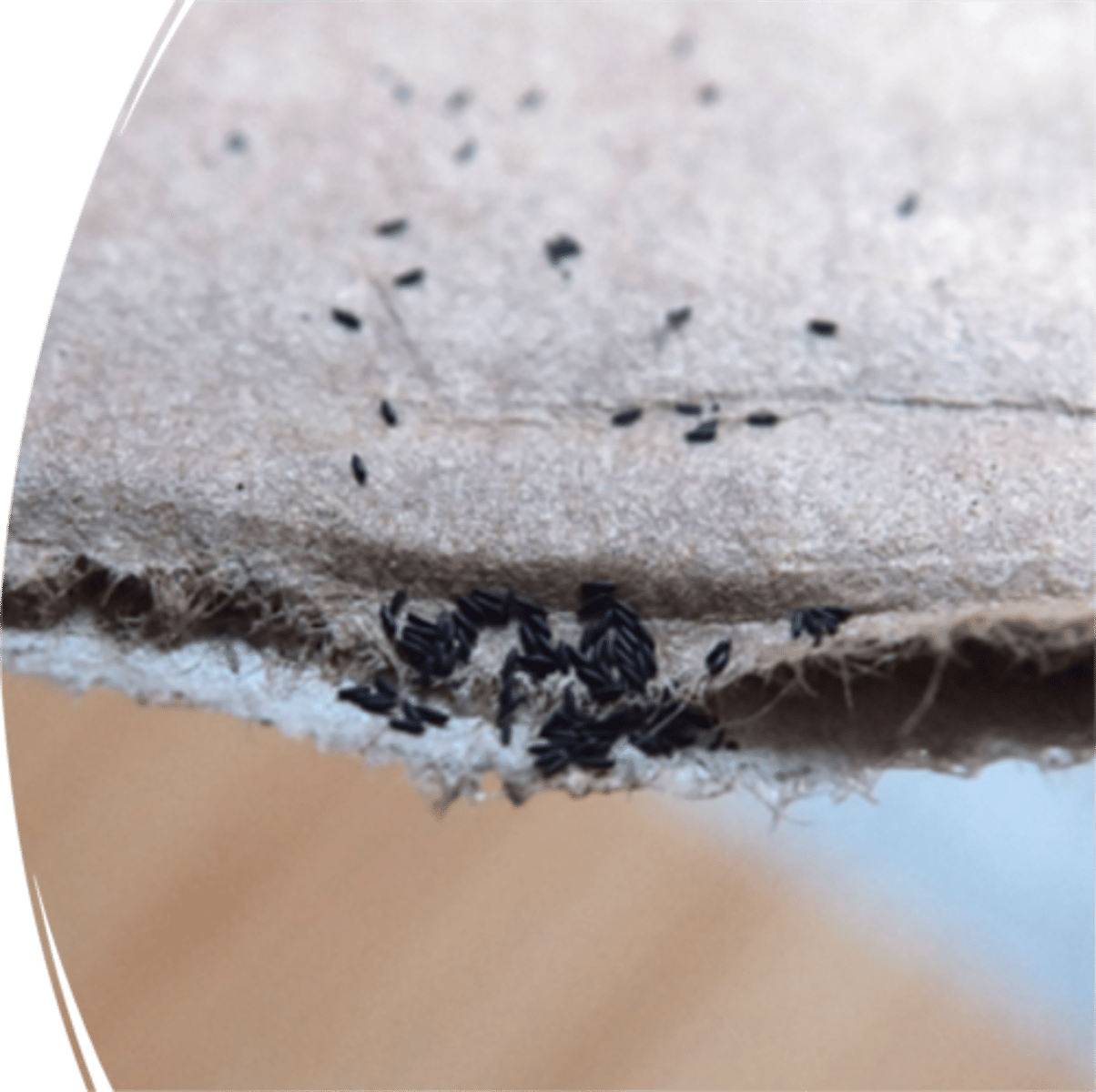
Aedes mosquito larvae
•Larvae emerge from mosquito eggs, but only after the water level rises to cover the eggs. This means that rainwater or humans adding water to containers with eggs will trigger the larvae to emerge.
•Larvae feed on microorganisms in the water. After molting three times, the larva becomes a pupa.
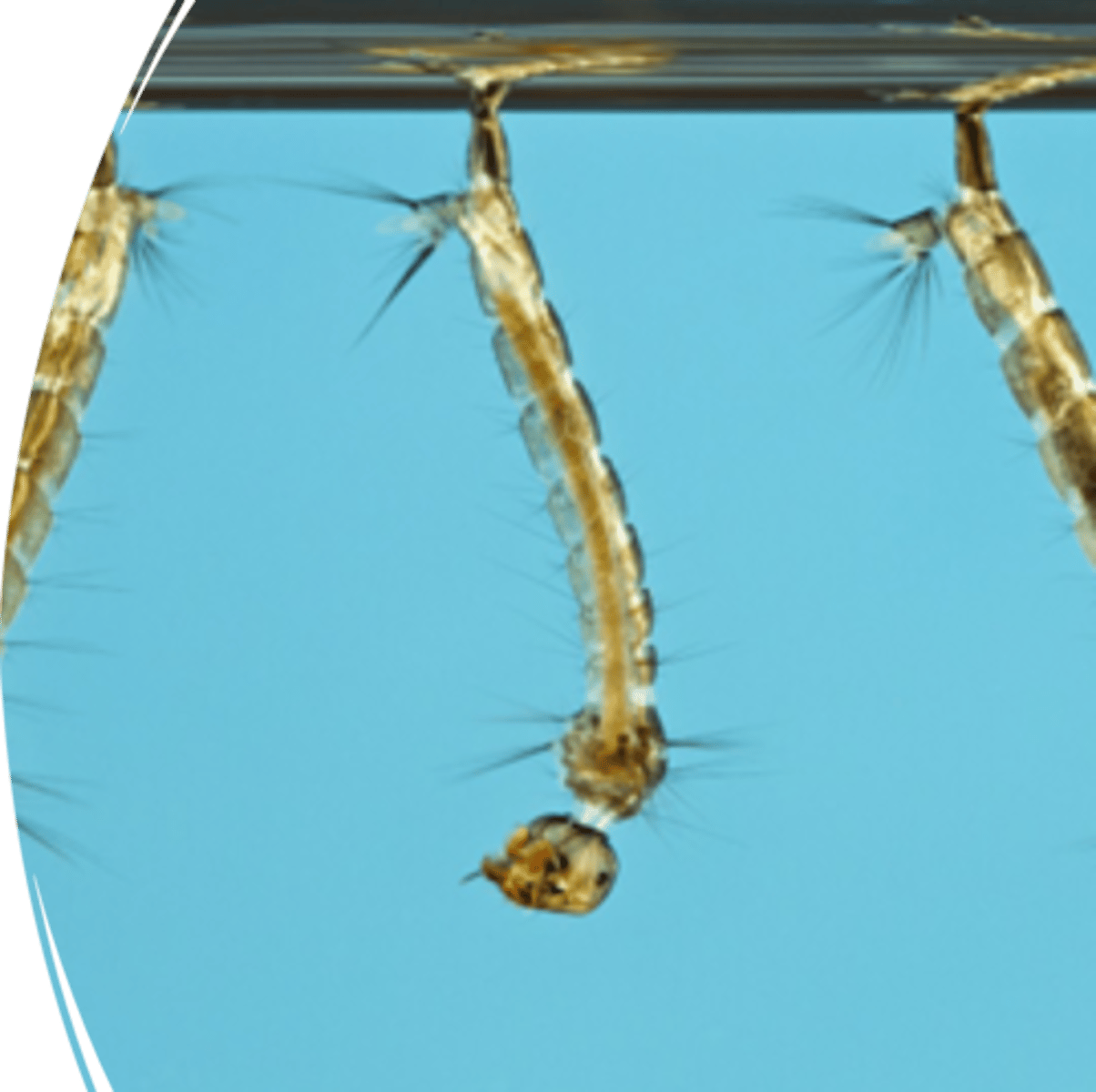
Aedes mosquito pupa
•Pupae will develop until the body of the newly formed adult flying mosquito emerges from the pupal skin and leaves the water.
